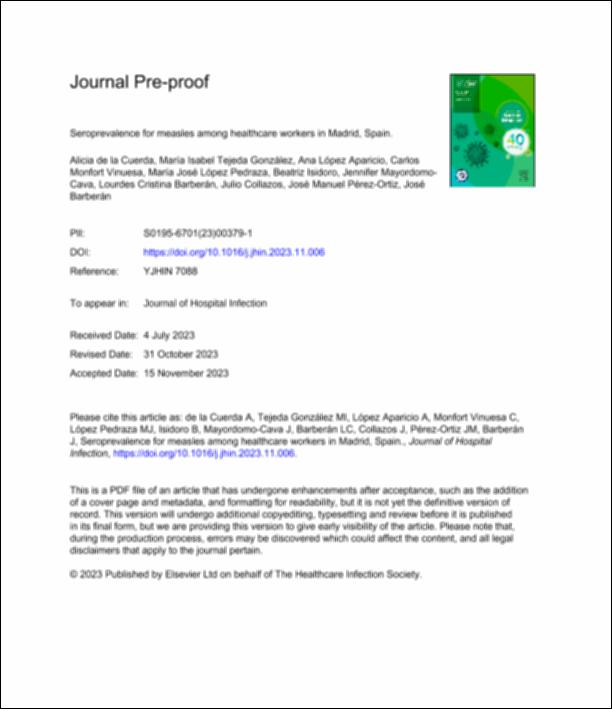Por favor, use este identificador para citar o enlazar este ítem:
http://hdl.handle.net/10637/15403Seroprevalence for measles among healthcare workers in Madrid, Spain.
| Título : | Seroprevalence for measles among healthcare workers in Madrid, Spain. |
| Autor : | Cuerda, Alicia de la Tejeda González, María Isabel López Aparicio, Ana Monfort Vinuesa, Carlos López Pedraza, María José Isidoro, Beatriz Mayordomo Cava, Jennifer Barberán, Lourdes Cristina Collazos, Julio Pérez Ortiz, José Manuel Barberán López, José |
| Materias: | Measles; Seroprevalence; Healthcare workers; Vaccination; Spain |
| Editorial : | Elsevier |
| Citación : | Seroprevalence for measles among healthcare workers in Madrid. de la Cuerda A, Tejeda González MI, López Aparicio A, Monfort Vinuesa C, López Pedraza MJ, Isidoro B, Mayordomo-Cava J, Barberán LC, Collazos J, Pérez-Ortiz JM, Barberán J., Spain. J Hosp Infect. 2023 Nov 29:S0195-6701(23)00379-1. doi: 10.1016/j.jhin.2023.11.006. Epub ahead of print. PMID: 38040037 |
| Resumen : | Background Immunity of healthcare workers (HCWs) against measles is a particular concern. They are more likely to contract it than the general population due to their occupational exposure which may cause a nosocomial outbreak. Aim To assess the measles immune status of HCWs at five Spanish university hospitals. Patients and methods Serologic testing (IgG) for measles by chemiluminescence indirect immunoassay (CLIA) was carried out prospectively and consecutively in HCWs from five university hospitals. All HCWs were classified into four epidemiological groups: vaccinated individuals, those with a history of measles disease, subjects with no history of measles or vaccination, and those who did not know if they had measles or were vaccinated, and into five professional categories: physicians, nurses, nursing assistants, other clinical workers, and non-clinical workers. A logistic regression model was constructed to identify the factors independently associated with immunity to measles. Results The study group was composed of 2157 HCWs. 89% had protective antibodies against measles. Of the 238 non-immune HCWs, 199 (83.6%) had been vaccinated as compared to 1084 of the 1919 (56.5%) immune individuals (p<0.0001). The parameters significantly predictive of having protective antibodies against measles were: older age (p<0.0001), epidemiological status (p=0.0002, mainly past measles disease), and professional category (p=0.02, particularly nurses). Conclusion This study shows that HCWs, including those previously vaccinated, are currently at risk of measles and suggests that those with a natural history of infection are better protected. Therefore, knowledge and maintenance of immunity to measles are an essential part of infection control among HCWs. |
| Descripción : | Versión en acceso abierto cumpliendo política de la editorial |
| URI : | http://hdl.handle.net/10637/15403 |
| Derechos: | http://creativecommons.org/licenses/by-nc-nd/4.0/deed.es |
| ISSN : | 0195-6701 |
| Fecha de publicación : | 29-nov-2023 |
| Centro : | Universidad San Pablo-CEU |
| Aparece en las colecciones: | Psicología |
Los ítems de DSpace están protegidos por copyright, con todos los derechos reservados, a menos que se indique lo contrario.


